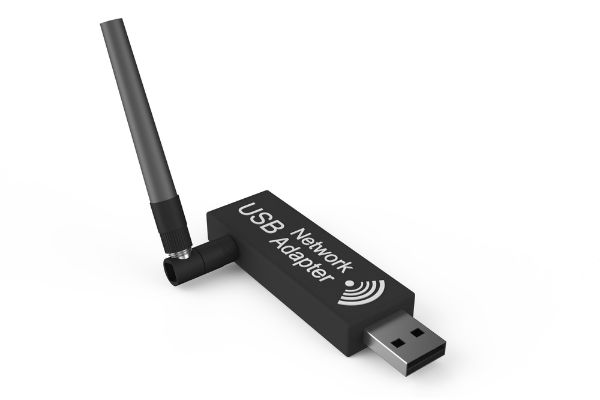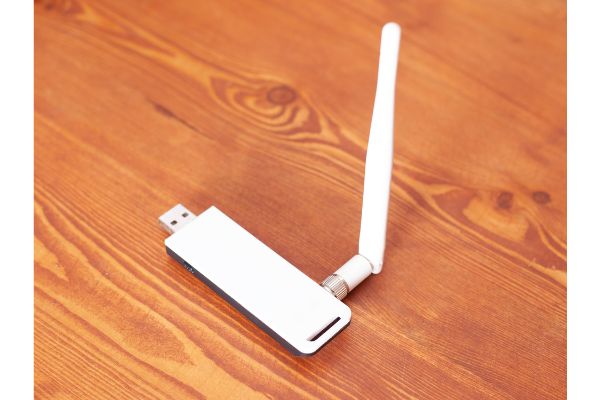Disclaimer: This post may contain affiliate links, meaning we get a small commission if you make a purchase through our links, at no cost to you. For more information, please visit our Disclaimer Page.
When most people think of getting on the internet, they probably picture a laptop or smartphone connecting to a Wi-Fi network. Perhaps they think of the router that must be somewhere nearby in order to distribute the signal from an internet service provider. While these things are all important pieces of the puzzle when it comes to humans getting online, there are other components that our devices need in order to complete this access.
One such part is a network adapter. Your desktop or laptop will have a network adapter somewhere inside of it, and it is a piece that helps your computer create an interface between itself and a Local Area Network, something you will see abbreviated as just a LAN. Typically, the network adapter is a small antenna or card that resides somewhere inside your computer.
If you’ve ever had trouble getting your laptop to connect to the area’s network, you may have seen some people in the tech field suggest that you try doing a network adapter reset. While this can be a helpful step to take, you may wish to know what happens when you do this. We will go over that topic in today’s article.
Additionally, we will cover some scenarios in which users might find that they need to reset their network adapters with far too much regularity in order to maintain online access, give you some possible signs of an adapter that is failing, and troubleshoot some checks that can tell you whether the adapter in your computer is working properly.
Table of Contents
What Does Resetting Network Adapter Do?
Even if you know how to reset your network adapter, you may not know exactly what this process is supposed to do for your computer. There are two main things that a reset does for the adapter. Firstly, a network reset clears out the list of networks that your computer saved.
If you recall back to when you set up your own Wi-Fi network at home, you hooked up your router, logged into its settings online, and created the network that you use for internet connectivity right now. Once you went through this whole process, you gave a name to the network you set up. This SSID then appeared in the list of available networks to which your computer could connect.
Now that you have everything set up the way you want it, your computer probably connects to that same network every time you open your laptop or turn on your desktop. However, you may notice a list of several other names under the usual network you use at home.
These are additional networks that other users set up nearby, or they are older networks that your computer once used to access the internet. In either case, resetting the network adapter clears out this list of known networks. Although your computer can discover them again, it will no longer have access to any of them after you reset the adapter.
The second main job of the network adapter reset is to disable the unit. Once the process turns the adapter off, it should re-initialize it automatically. The reset does this by taking out and then reloading the driver that your computer associates with the network adapter.
A driver is a specific set of instructions that tells the hardware in your computer how to behave in order to do what you need. When you tell the computer to reset its network adapter, this will also reload various network settings that you changed, and they will revert back to their default values.
Since it is possible that one or more of the settings you updated could be causing some issues, a reset may solve your connectivity problems. This is true even if your network connection seemed to be fine recently. Before moving on, we should note that a reset of this type also wipes any network information that the computer stored within itself.
This means that security information protocols such as SSIDs and passwords are not things the device grabs automatically anymore. Therefore, it is vital that you store or memorize this information in order to get back online later.
Why Do I Need To Keep Resetting My Wi-Fi Adapter? (Solved!)
Although a network adapter reset can help many people get back online and stay there, some users experience glitches that seem to need regular resets of the adapter in order to stay online.
This is unusual behavior, so it is important to narrow down the list of possible reasons as to why it is occurring.
Once you know the main reasons why you need to perform resets on a schedule, you may be able to solve the issue. Although our list may not explain every possible scenario, here are some of the primary culprits of Wi-Fi adapter problems:
1. There could be a configuration issue with your adapter or its settings. Most times, the settings must be precise in order to facilitate communication between the computer and your Wi-Fi router.
If anything is off, it may cause problems with the connection. Because you can adjust some settings, it is possible that a reset of the adapter makes it easier for the devices to communicate.
2. The drivers that your adapter uses need to be up to date in order for things to work. Although some adapters can work for a while when they run outdated drivers, this phase usually does not last long.
Keeping drivers up to date allows the Wi-Fi adapter to get all of the instructions it needs in order to function properly.
3. If you have certain power management settings active on your computer, you could be losing your Wi-Fi connection based on the device’s need to conserve energy.
Check your power settings to see if you need to adjust them. You may need to turn some power conservation options off in order to ensure that the adapter keeps an active connection to the router.
4. If there is a problem with your authentication process, your Wi-Fi adapter may drop the signal regularly. Check to make sure that your authentication credentials are correct.
What Are Some Signs of a Faulty Wi-Fi Adapter?
Although there is not one hard rule for determining the health of a Wi-Fi adapter, here are a few signs for which you can look:
1. If you boot up your computer and don’t see any available networks in the appropriate list, there may be a fault in your Wi-Fi adapter. It should scan for networks automatically, and if it fails to locate any, it might be going out.
2. We spoke previously about some of the reasons why you might have to keep resetting the adapter, but dropped connections could indicate a bad unit.
While authentication and other issues could contribute to this, you may experience this problem when you know everything is in order. If so, the Wi-Fi adapter might be going into some kind of failure mode.
3. If your speeds are much slower than the internet package for which you are paying, you could be dealing with a bad adapter. Check your speeds regularly using one of several websites. Consistently slow download and upload speeds could be indicative of a faulty adapter.
4. Your computer may send you messages that will pop up on the screen. If you are getting such messages regularly, it may be because the Wi-Fi adapter is failing. Always check pop-ups before you close them. If the messages relate to your Wi-Fi status, your adapter could be the culprit.
How Do I Know if My Wi-Fi Adapter Is Working?
Just like a card or other kind of adapter that is not working, there are ways to test yours to make sure that it is in order. Here are a few guidelines that you can follow:
1. Check to see if your computer recognizes the adapter card at all. To do this, you can go to your computer’s Control Panel and access the Device Manager. Once you are here, check out the Network Adapter section to see if yours is on the list.
2. Again, you can go to the Control Panel. This time, visit the Network and Sharing Center. This is a location from which you can see all the available connections, just like you can in the taskbar menu under your Wi-Fi icon. If you see a list of connections, it is a good indication that your adapter is working.
3. You can ping various websites. Pinging involves your computer sending out a tiny bit of data, and the adapter will test how long it takes to receive any data back from the site.
All you need to do for this is open the Command Prompt program. In here, you can type the ’ping’ command followed by a web address. Then, just wait for the results to see if you have an active adapter card.
Conclusion
Wi-Fi adapters are an important piece of tech in any computer, and they allow the devices to interface with others that give us online access. Occasionally, you may need to reset your computer’s adapter to get rid of problems. However, you shouldn’t need to do this very often. If you find that you have to do it regularly, it could indicate another problem with the hardware. Should you suspect anything, you can use our tips above to run a few tests on your own adapter card.


